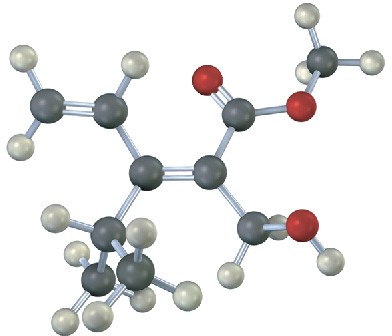4.4 Alkene Stereochemistry and the E,Z Designation
The cis–trans naming system used in the previous section works only with disubstituted alkenes—compounds that have two substituents other than hydrogen on the double bond. With trisubstituted and tetrasubstituted double bonds, a more general method is needed for describing double-bond geometry. (Trisubstituted means three substituents other than hydrogen on the double bond; tetrasubstituted means four substituents other than hydrogen.)
The method used for describing alkene stereochemistry is called the E,Z system and employs the same Cahn–Ingold–Prelog sequence rules given in Section 3.5 for specifying the configuration of a chirality center. Let’s briefly review the sequence rules and then see how they’re used to specify double-bond geometry. For a more thorough review, reread Section 3.5.
RULE 1
Considering each of the double-bond carbons separately, look at the two substituents attached and rank them according to the atomic number of the first atom in each (8 for oxygen, 6 for carbon, 1 for hydrogen, and so forth). An atom with higher atomic number ranks higher than an atom with lower atomic number.
RULE 2
If a decision can’t be reached by ranking the first atoms in the two substituents, look at the second, third, or fourth atoms away from the double-bond until the first difference is found.
RULE 3
Multiple-bonded atoms are equivalent to the same number of single-bonded atoms. Once the two groups attached to each double-bonded carbon have been ranked as either higher or lower, look at the entire molecule. If the higher-ranked groups on each carbon are on the same side of the double bond, the alkene is said to have a Z configuration, for the German zusammen, meaning “together.” If the higher-ranked groups are on opposite sides, the alkene has an E configuration, for the German entgegen, meaning “opposite.” (For a simple way to remember which is which, note that the groups are on “ze zame zide” in the Z isomer.)
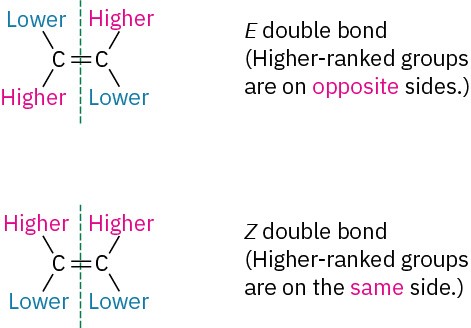 As an example, look at the following two isomers of 2-chloro-2-butene. Because chlorine has a higher atomic number than carbon, a −Cl substituent is ranked higher than a −CH3 group. Methyl is ranked higher than hydrogen, however, so isomer (a) is designated E because the higher-ranked groups are on opposite sides of the double bond. Isomer (b) has a Z configuration because its higher-ranked groups are on ze zame zide of the double bond.
As an example, look at the following two isomers of 2-chloro-2-butene. Because chlorine has a higher atomic number than carbon, a −Cl substituent is ranked higher than a −CH3 group. Methyl is ranked higher than hydrogen, however, so isomer (a) is designated E because the higher-ranked groups are on opposite sides of the double bond. Isomer (b) has a Z configuration because its higher-ranked groups are on ze zame zide of the double bond.
 For further practice, work through each of the following examples to convince yourself that the assignments are correct:
For further practice, work through each of the following examples to convince yourself that the assignments are correct:
 Worked Example 4.1: Assigning E and Z Configurations to Alkenes
Worked Example 4.1: Assigning E and Z Configurations to Alkenes
Assign E or Z configuration to the double bond in the following compound:
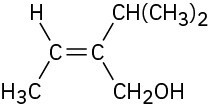
Strategy
Look at the two substituents connected to each double-bonded carbon, and determine their ranking using the Cahn–Ingold–Prelog rules. Then, check whether the two higher-ranked groups are on the same or opposite sides of the double bond.
Solution
The left-hand carbon has −H and −CH3 substituents, of which −CH3 ranks higher by sequence rule 1. The right-hand carbon has −CH(CH3)2 and −CH2OH substituents, which are equivalent by rule 1. By rule 2, however, −CH2OH ranks higher than −CH(CH3)2 because the substituent −CH2OH has an oxygen as its highest second atom, but −CH(CH3)2 has a carbon as its highest second atom. The two higher-ranked groups are on the same side of the double bond, so we assign a Z configuration.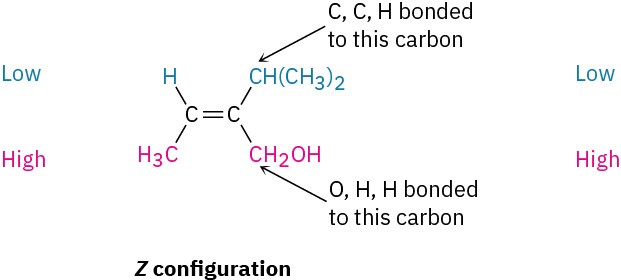 Problem 4.9
Problem 4.9
Which member in each of the following sets ranks higher?
(a)−H or −CH3
(b)−Cl or −CH2Cl
(c)–CH2CH2Br or –CH=CH2
(d)−NHCH3 or −OCH3
(e)−CH2OH or −CH=O
(f)−CH2OCH3 or −CH=O
Problem 4.10
Rank the substituents in each of the following sets according to the sequence rules:
(a)−CH3, −OH, −H, −Cl
(b)−CH3, −CH2CH3, −CH=CH2, −CH2OH
(c)−CO2H, −CH2OH, −C≡N, −CH2NH2
(d)−CH2CH3, −C≡CH, −C≡N, −CH2OCH3
Problem 4.11
Assign E or Z configuration to the following alkenes:
(a)
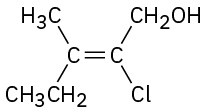
(b)
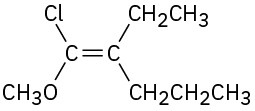
(c)
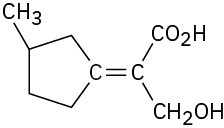
(d)
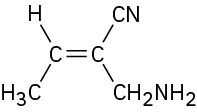
Problem 4.12
Assign stereochemistry (E or Z) to the double bond in the following compound, and convert the drawing into a skeletal structure (red = O):
